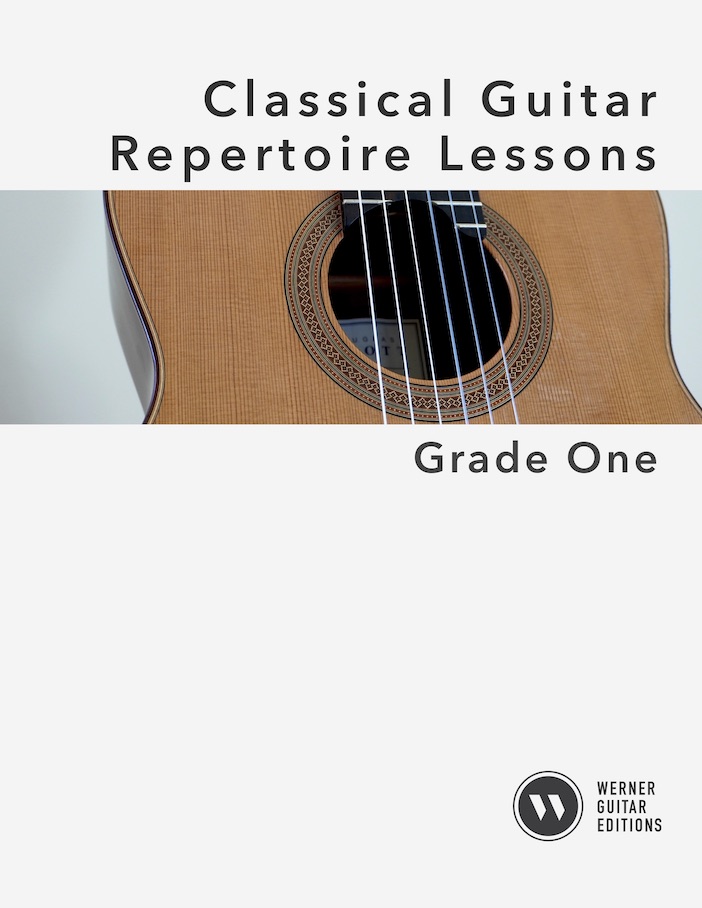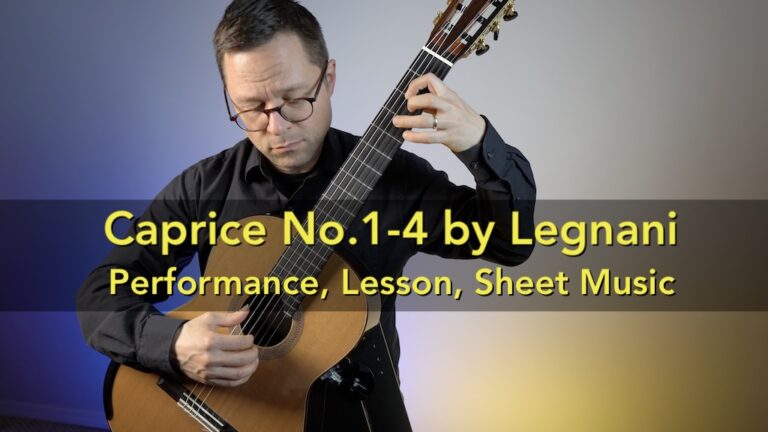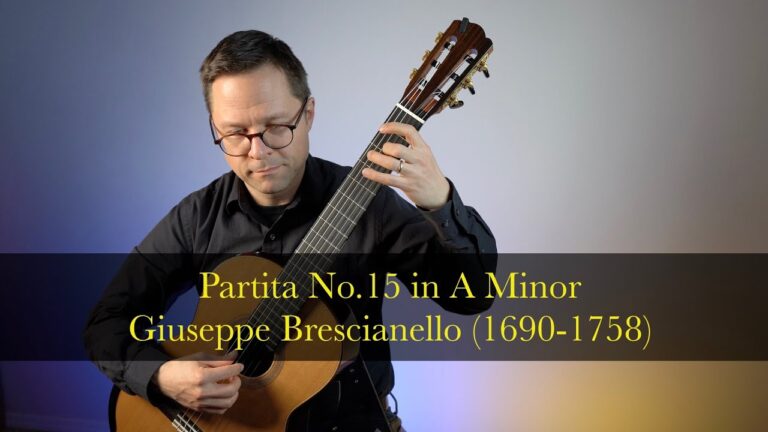
Classical Guitar Repertoire Lessons Grade 1 – This book combines a method book and repertoire collection. Each grade 1 piece has dedicated lesson pages before the piece is presented in full. All lessons and pieces are in notation with fingering. Watch the free video lessons for additional advice. A separate TAB supplement at the end includes the pieces (not the lessons). PDF Download or Hardcopies via Amazon. 39 Pages. 2019 Edition.
Buy the PDF at My Sheet Music Store
Hardcopies (Grade 1-2) via: Amazon.com, Amazon.ca, Amazon.co.uk, or your country’s Amazon.
About & Level: This book teaches classical guitar repertoire at approximately the grade one level. This level is appropriate for students who have completed both my Volume 1 and Volume 2 method books. The pieces in this book appear in a progressive order starting with easy pieces and slowly introducing new techniques, oddity fingerings, or increased activity. The main goal is to teach students how to practice their repertoire by breaking it down into separate elements. Check out the samples in the image gallery on Werner Guitar Editions. Keep in mind that this book has no connection to other graded systems, some selections are harder or easier for variety and skill development. After completing this book you can consider working on my Repertoire Supplement Grade 1 – Ten additional pieces to play.
Contents – Each piece has two or three pages of lessons followed by a proper performance edition of the piece.
- The Spanish Pavin (Anonymous) – Melody-focused Renaissance dance
- Lección 75 by Julio Sagreras – Melody combined with arpeggios and chords (Argentina)
- Lección 70 by Julio Sagreras – Three-voice texture with a clear melody (Argentina)
- Ècossaise Op.33, No.2 by Mauro Giuliani – Simple slurs and muted bass strings
- Lección 19 by Dionisio Aguado – Arpeggio etude with three-voice chords
- La Tirantine by Adrian Le Roy – Renaissance dance with melody and full chord shapes
- Andantino Op.241, No.5 by Ferdinando Carulli – Increased activity, melody and alberti bass
- Exercise No.11 by Napoléon Coste – A brief foray into upper positions
Video Lessons for this Book
- Lesson: The Spanish Pavin (Anonymous)
- Lección 75 by Julio Sagreras
- Lección 70 by Julio Sagreras
- Ècossaise Op.33, No.2 by Mauro Giuliani
- Lección 19 by Dionisio Aguado
- La Tirantine by Adrian Le Roy
- Andantino Op.241, No.5 by Ferdinando Carulli
- Exercise No.11 by Napoléon Coste
Student FAQ:
Should I memorize the pieces and should I keep them in my repertoire? Although I’m not strict about memorization with my students, I do believe that we play better when the piece is memorized. Also, our brains seem to get used to it as a habit and memorizes more efficiently if we do it regularly. So, I highly recommend you memorize your pieces but don’t be too hard on yourself, just do a little bit of memory work everyday and see how it goes.
When should I move onto the next piece? Aim for a confident playing of the piece. As a basic check you might put a metronome on and be able to play through it as that is a common issue. Aim for an even rhythm, nice tone, arched phrases, and a prominent melody. I encourage students to stick with pieces for awhile to see how they ‘settle’ into the piece in terms of relaxation. It’s important to dive deeper into musicality after you have accomplished the basic physical movements. A large part of what teachers do is to just raise the musical bar and get students to strive for higher levels of musicality so you’ll want to push yourself in that regard to ensure you are not just settling for a past standard (up your personal level every piece). In the end it’s up to you but try to feel confident and happy with your performance.
More books from this site
- Education Series (Methods & Technique)
- Classical Guitar Method Volume 1, 100 pages, Free PDF
- Classical Guitar Method Volume 2, 89 pages
- Classical Guitar Repertoire Lessons Grade 2
- Classical Guitar Repertoire Lessons Grade 3
- Classical Guitar Technique: Essential Exercises, Scales, & Arpeggios – 122 pages, video lessons





Thanks! I have found these very helpful! I’ve played bluegrass and rock guitar for many years, but am just starting with classical (my pandemic project). One simple thing that would be helpful is suggested metronome settings for each song. I generally aim for the tempos in your videos, but having numbers would help me be more methodical in my practice.
Hi, yes I realize that metronome markings might be nice for some people but they can also be devastating for others. At early levels the focus must remain on legato, phrasing, and quality technique in terms of foundation building. Trying to reach a speed can be detrimental to that outlook. That said, I think most students should aim for a slightly slower tempo than the ones I present.